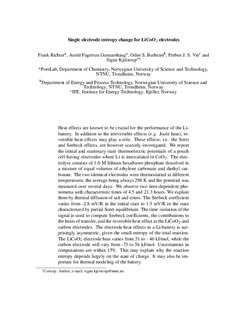Single Electrode Entropy Change for LiCoO2 Electrodes
Richter, Frank; Gunnarshaug, Astrid Fagertun; Burheim, Odne Stokke; Vie, Preben Joakim Svela; Kjelstrup, Signe Helene
Journal article
Submitted version
Permanent lenke
http://hdl.handle.net/11250/2473888Utgivelsesdato
2017Metadata
Vis full innførselSamlinger
- Institutt for energi og prosessteknikk [4257]
- Institutt for kjemi [1402]
- Publikasjoner fra CRIStin - NTNU [38576]
Sammendrag
Heat effects are known to be crucial for the performance of the Li-battery. In addition to the irreversible effects (e.g. Joule heat), reversible heat effects may play a role. These effects, i.e. the Soret and Seebeck effects, are however scarcely investigated. We report the initial and stationary state thermoelectric potentials of a pouch cell having electrodes where Li is intercalated in CoO2. The electrolyte consists of 1.0 M lithium hexafluoro phosphate dissolved in a mixture of equal volumes of ethylene carbonate and diethyl carbonate.The two identical electrodes were thermostatted at different temperatures, the average being always 298 K and the potential was measured over several days. We observe two time-dependent phenomena with characteristic times of 4.5 and 21.3 hours. We explain them by thermal diffusion of salt and esters. The Seebeck coefficient varies from -2.8 mV/K in the initial state to 1.5 mV/K in the state characterized by partial Soret equilibrium. The time-variation of the signal is used to compute Seebeck coefficients, the contributions to the heats of transfer, and the reversible heat effect at the LiCoO2-and carbon electrodes. The electrode heat effects in a Li-battery is surprisingly asymmetric, given the small entropy of the total reaction.The LiCoO2 electrode heat varies from 51 to - 46 kJ/mol, while the carbon electrode will vary from -73 to 56 kJ/mol. Uncertainties in computations are within 15%. This may explain why the reaction entropy depends largely on the state of charge. It may also be important for thermal modeling of the battery.
